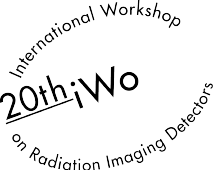Speaker
Description
Integrated charge-sensitive preamplifiers suffer from a reduced available dynamic range respect to discrete-type equivalents. This is due to the limits on maximum supply voltages that modern scaled technologies can tolerate. In this work we present a low-noise low-power integrated charge-sensitive preamplifier (CSP) for solid-state detectors. This device is equipped with an integrated range-booster that can enhance the spectroscopic range of the preamplifier by more than one order of magnitude, enabling high-resolution spectroscopy even if the preamplifier is in deep saturation condition.
If the input signals from the detector are under the natural saturation threshold (40 MeV), the preamplifier works in an usual linear way, producing at the output the typical exponential signals. With proper filtering a resolution of approximately 1 keV is achievable. When a large signal from the detector saturates the preamplifier, a sensing circuit detects the saturation and switches the operation mode of the CSP to the “fast-reset mode”. In this mode a constant and controlled current generator discharges the input node of the preamplifier until the normal operating point is reached. Meanwhile an auxiliary circuit similar to a TAC (Time-to-Amplitude converter) retrieves the energy of the signal that caused saturation. Although the natural dynamic range of the CSP is 40 MeV, the fast-reset mode enables for high-resolution spectroscopy (under 0.2% FWHM) up to several hundreds of MeV (700_MeV typically).
One issue in this kind of circuits is the dependence of the energy measured with the TAC circuit on the baseline value of the CSP before the “fast-reset event” [1]. As a solution to this problem we propose a correction algorithm implemented inside the TAC block in the form of an analog circuit.
On a test-bench a series of large 3 pC charge signals is injected in the input node of the preamplifier through a test capacitor. Before these events, residual charges ranging from 0 to 0.56 pC produce non-zero baseline voltages at the output of the CSP. The TAC with correction not only retrieves correctly the energy of the main event, but also rejects the baseline voltages, leaving the energy measurement unaffected. The fluctuations of the flat-top voltage in the signals produced by the auxiliary TAC circuit due to the different baseline voltages are under the 0.6% of the total signal amplitude.
[1] A. Pullia, F. Zocca, G. Pascovici, and D. Bazzacco, “Extending the dynamic range of nuclear pulse spectrometers,” Review of Scientific Instruments, vol. 79, no. 3, p. 36105, Mar. 2008.
